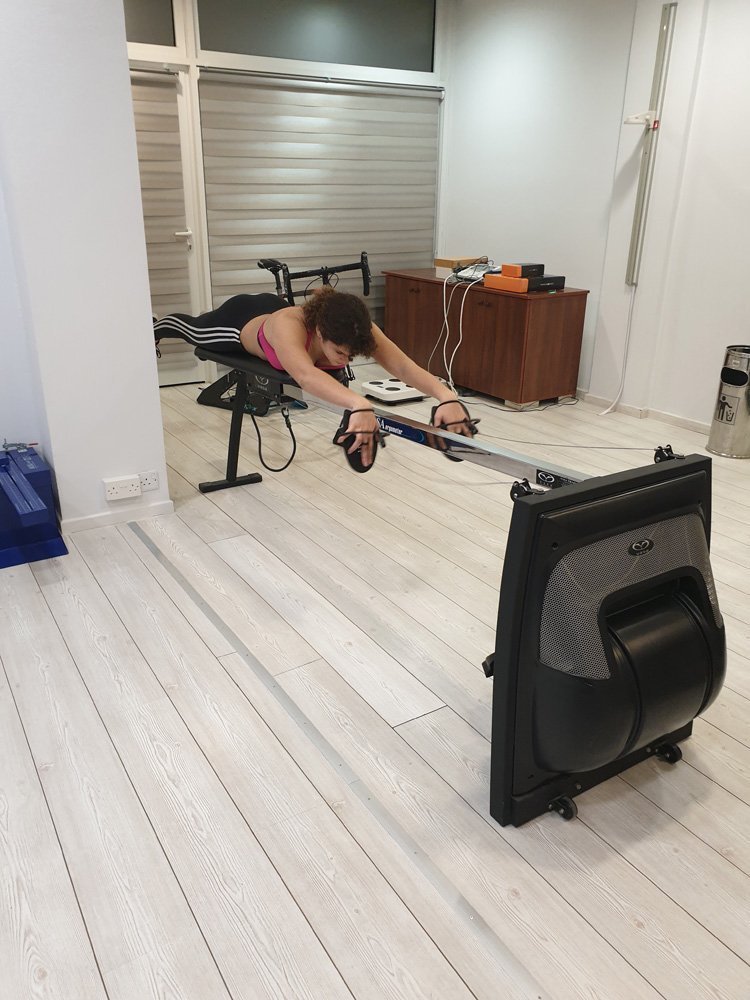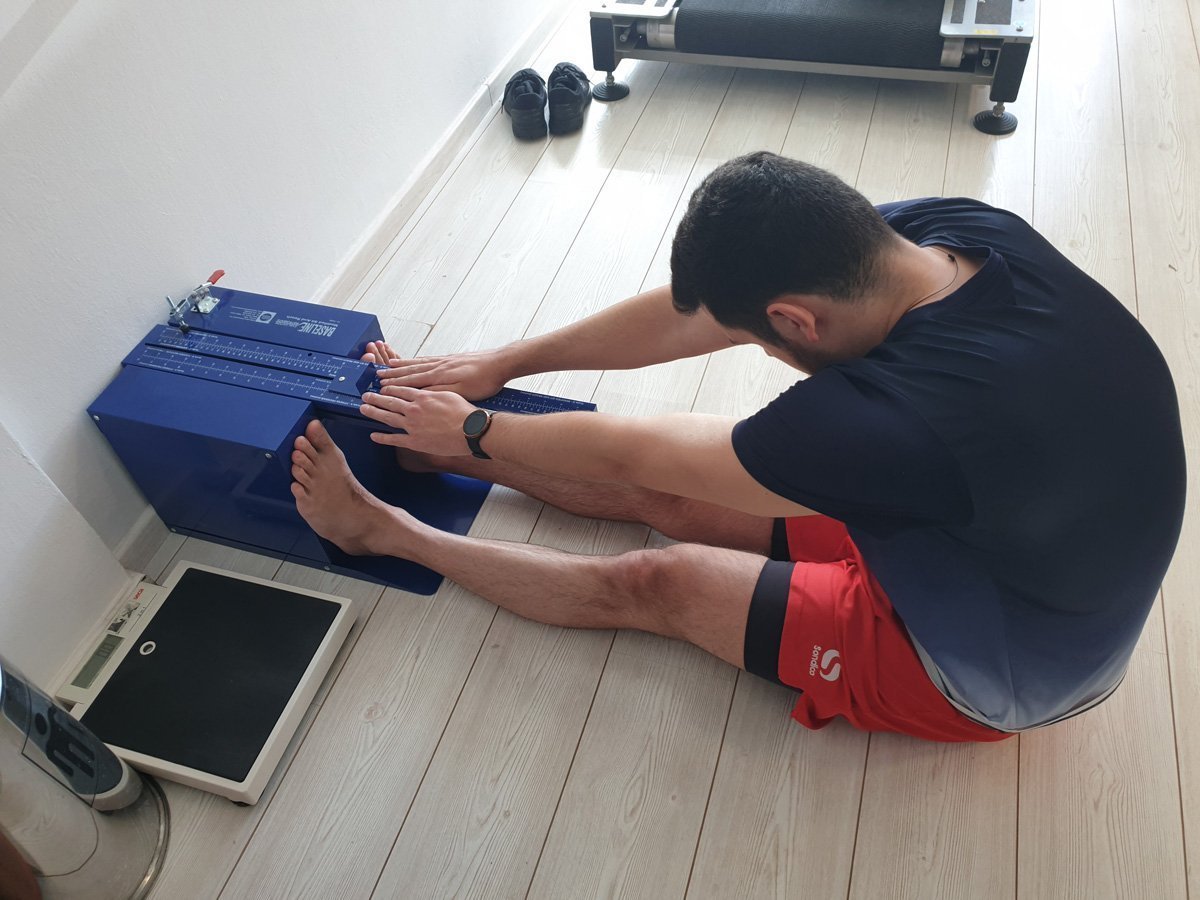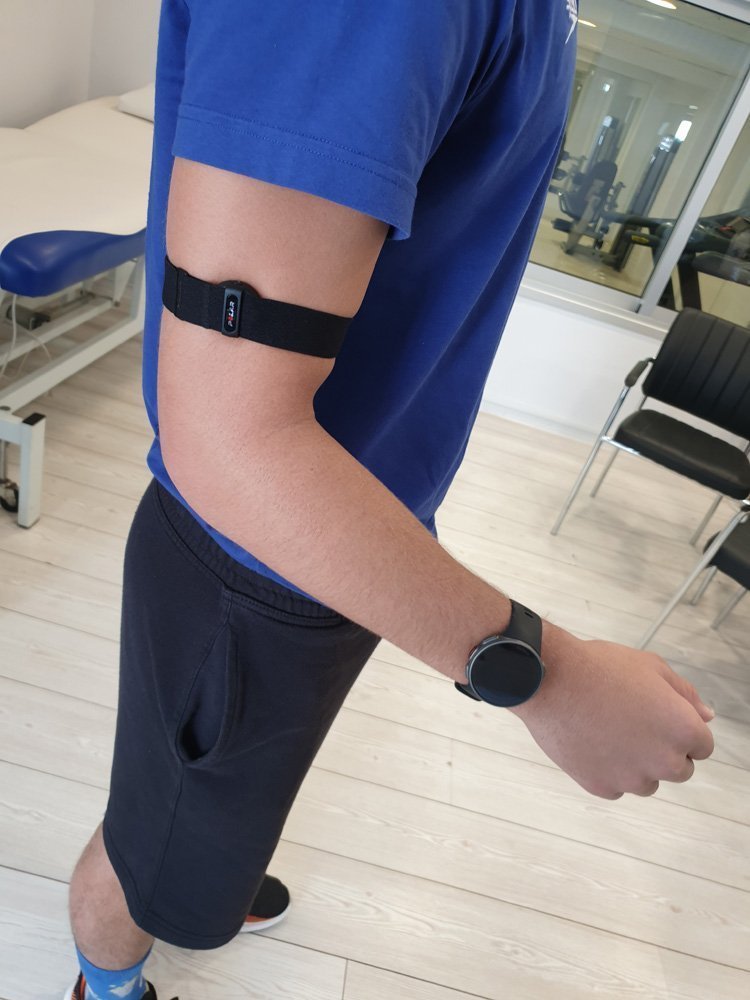Cardiopulmonary evaluation system / Ergospirometer
Treadmill, bicycle, rowing machine
- Fitness and endurance control
- Maximum oxygen uptake (VO2max)
- Definition of aerobic and anaerobic threshold
- Basal metabolic rate and metabolic rate during exercise
- Rate of carbohydrate and fat use
- Definition of exercise intensities for maximum fat burning
- Lung volume and gas exchange (O2 & CO2)
- Εξακρίβωση εντάσεων για μέγιστη καύση λίπους
- Heart rate monitoring at rest and during exercise
- Monitoring of percentage of oxygen in the blood (SpO2) at rest and during exercise
These ergometric tests can be carried out on a treadmill, bicycle, or rowing machine. In the case of cycling, the use of a smart trainer allows the client to bring in and utilize their own bicycle during the tests if they wish to. A static bicycle is also available.
Advantages of use by everyday individuals
The identification of the appropriate exercise intensities leads to the development of more effective exercise regimes. Through appropriate and effective exercise, the quality of life of the individual can be improved; either through the increase or decrease of body weight and body fat or through the improved haematological and biochemical markers (cholesterol, triglycerides, liver enzymes etc.)
Advantages of use by athletes
The identification and definition of weaknesses in the aerobic and/or anaerobic capacity can lead to specialized training in those sectors for the athlete, resulting in increased and improved performance.
Swimming ergometer
Trainer
With the use of the swimming ergometer the strengthening of the upper body and training on land is made possible. Additionally, the swimmer’s technique can be easier corrected or adjusted on land, than in the water.
- for assessment of upper body strength during the movements of each stroke (freestyle, butterfly, breaststroke, backstroke)
- for strengthening of the upper body in case of injury
- or training in case the access to a pool is limited
Vertical jump, reaction and gait analysis system
This system is comprised of 2 bars, that communicate through LED lights, and 2 cameras.
Main functions
The main functions of the system are vertical jump measurements, measurements of explosiveness and reaction and the gait and running analysis.
For the vertical jump measurement, there are multiple tests: on a single leg, on both legs, from standing position or from squat position, with countermovement or without etc.
The same principle apply for the measurements of explosiveness and reaction: there are acoustic tests, visual tests, tests that use simple movements or more complex movements.
The same principle apply for the measurements of explosiveness and reaction: there are acoustic tests, visual tests, tests that use simple movements or more complex movements.
Finally, this system can be placed on either sides of a treadmill and can record different parameters related to walking or running. Among those parameters are the step’s length, time of “flight”, time from the first contact of the foot on the ground to the end of the contact etc.
For all the parameters, a comparison is made between the right and left leg and asymmetries can be identified. These asymmetries are the main reason behind chronic injuries.
Using the cameras to obtain footage from the side and the back, any mistakes in technique, any weaknesses or any asymmetries become more distinct and thus more manageable.
Dynamometers: muscle, stance, and grip
The above systems are being used for the measurement of muscle strength
Muscle Dynamometers
Most muscle groups can be assessed using the hand-held dynamometer using the appropriate test. Amongst others, there are 4 hamstring tests, 6 tests for the shoulder area and 2 tests for ankle strength.
Stance Dynamometers
Using the plates that are placed on the ground, the client’s stance can be assessed; does the client lean on the right/left or front/back. Additionally, any exercise can be tested that can be performed while standing such as squats, deadlifts.
Grip Dynamometers
The hand grip dynamometer provides information on the strength of the grip of course but also on the strength of the wrists and generally that of the arms.
Advantages
The main advantage in knowing the strength of each muscle group in any particular part of the body is the identification of possible asymmetries or weaknesses that usually result in injuries.
These dynamometers can also be used in periods of rehabilitation and reintegration, most frequently post-injury, to define the intensity and load of the exercise as well as assess the progress of the client/patient.
Body fat measurements
2 options for measuring body fat
Methods
At the lab we offer 2 options for measuring body fat: through Bioimpedance Analysis (BIA) and through the manual skinfold measurements using a caliber.
Automatic
The BIA method provides, other than the percentage of body fat, information regarding different somatic and metabolic parameters. Some measurement examples are muscle and bone mass, visceral fat, total body water, symmetry in the muscle and fat mass in each arm and leg and in the core, basal metabolic rate kai metabolic age. Based on the results of this method, a regime of exercise and nutrition can be constructed to address or improve any problems or weaknesses. This specific test can be repeated every minimum 3 months.
Manual
The second method of skinfold measurements is mainly used in athletes but also for body fat assessment between the measurements of the first method. The body fat percentage in this method is calculated by measuring the skinfold thickness in different part of the body, specifically the ones in which humans tend to store fat (abdomen, upper part of the arms and legs, back etc.).
Body fat measurements, regardless of nature, should be done systematically, especially when there is a target, in order to monitor the progress and identify motives and avoid them where applicable.
Heart Rate Monitors & Devices
Heart rate monitoring is more accurate and adaptable than ever. Heart rate can be monitored, during exercise or during testing, using different approaches: through the traditional chest strap, through smart watches that show the heart rate in real-time or through optical sensors that can be worn on a strap around the arm, leg or in case of swimming, on the goggles contacting the temples.
Device for measuring the percentage of oxygen in the blood (SpO2)
For the safe execution of the tests or the exercise, the device for measuring the percentage of oxygen in the blood (SpO2) is available at any time. In case the oxygen percentage drops below the normal levels, that means that the client/patient is not getting enough oxygen and any activity must be stopped immediately.
Devices for blood lactate measurements
The measurement of the concentration of lactate in the blood is extremely important since this fatigue factor plays a main role in the assessment of fitness. Knowing at which intensity lactate starts to build up, at what pace this production and build up of lactate is happening, what is the impact of lactate accumulation on the performance and at what pace the human metabolism can remove lactate, we can identify the points in training, specific sectors that need further attention. Blood lactate is among the largest fatigue factors and many weakness in performance are rooted in the production, resistance and/or removal of it.





